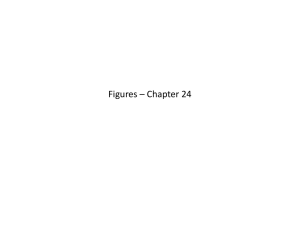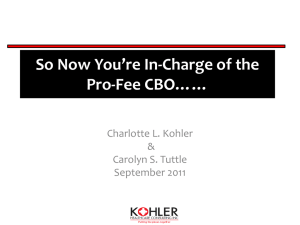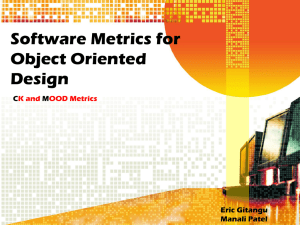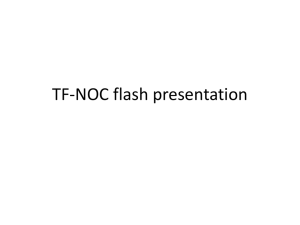Slides - Crest
advertisement
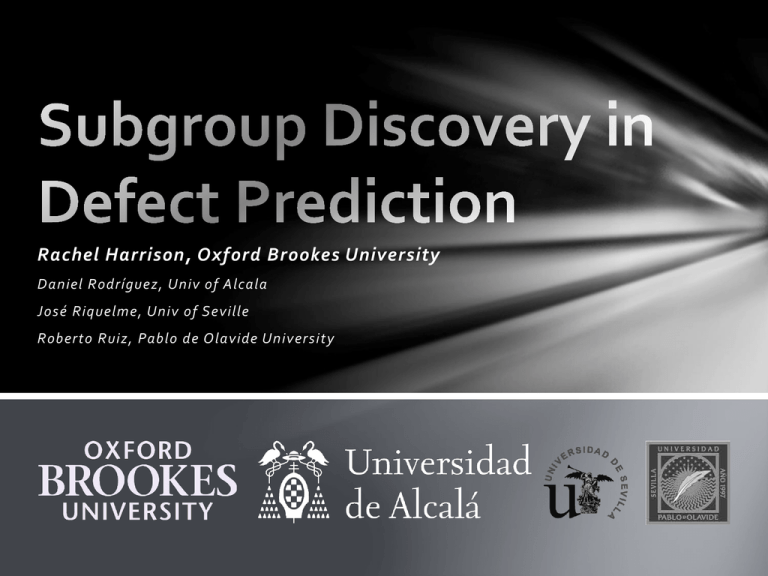
Rachel Harrison, Oxford Brookes University Daniel Rodríguez, Univ of Alcala José Riquelme, Univ of Seville Roberto Ruiz, Pablo de Olavide University Outline Supervised Description Subgroup Discovery Preliminary Experimental Work • Datasets • Algorithms (SD and CN2-SD) • Results Conclusions and future work Descriptive Models Typically, ML algorithms have been divided into: • Predictive (Classification, Regression, temporal series) • Descriptive (Clustering, Association, summarisation) Recently, supervised descriptive rule discovery is being introduced in the literature. • The aim is to understand the underlying phenomena, not to classify new instances, i.e., to find information about a specific value in the class attribute. • The information should be useful to the domain expert and easily interpretable. • Types of supervised descriptive techniques include: • Contrast Set Mining (CSM) • Emerging Pattern Mining (EPM) • Subgroup discovery (SD) SD – Definition SD algorithms aims to find subgroups of data that are statistically different given a property of interest. [Klösgen, 96; Wrobel, 97] • SD lies between predictive (finding rules given historical data and a property of interest) and descriptive tasks (discovering interesting patterns in data). • SD algorithms generally extract rules from subsets of the data, having previously specified the concept, for example defective modules from a software metrics repository. • Rules have also the "Condition → Class" where the condition is the conjunction of a set of selected variables (pairs attribute–value) among all variables. • Advantages of rules include that they are well known representations easily understandable by the domain experts • So far, SD has mostly been applied to the medical domain. SD vs. Classification Induction Output Purpose Classification Predictive Set of classification rules (dependent rules) Subgroup Discovery Descriptive Individual Rules to describe subgroups (independent rules) To learn a model for classification or prediction To find interesting and interpretable patterns with respect to a specific attribute SD vs. Classification S3 S1 Following [Herrera et al, 2011] S2 SD Algorithms SD algorithms could be classified as: • Exhaustive (e.g.: SD-map, Apriori-SD) • Heuristic (e.g.: SD, CN2-SD) • Fuzzy genetic algorithms (SDIGA, MESDIF, EDER-SD) Or from their origin, evolved from different communities: • Extension of classification algorithms (SD, CN2-SD, etc.) • Extension of association algorithms (Apriori-SD, SD4TS, SD-Map, etc.) Comprehensive survey by [Herrera et al. 2011] Quality Measures in SD Measures of Complexity • Number of rules: It measures the number of induced rules. • Number of conditions: It measures the number of conditions in the antecedent of the rule. Measures of Generality • Coverage: 𝐶𝑜𝑣 𝑅 = 𝑛(𝐶𝑜𝑛𝑑) 𝑁 where N is the number of samples and n(Cond) is the no. of instances that satisfy the antecedent of the rule. • Support: 𝑆𝑢𝑝 𝑅 = 𝑛(𝐶𝑜𝑛𝑑·𝐶𝑙𝑎𝑠𝑠) 𝑁 where n(Cond · Class) is the no. of instances that satisfy both the condition and the class Quality Measures in SD Measures of precision • Confidence: 𝐶𝑜𝑛𝑓 𝑅 = 𝑛(𝐶𝑜𝑛𝑑·𝐶𝑙𝑎𝑠𝑠) 𝑛(𝐶𝑜𝑛𝑑) • Precision Qc : 𝑄𝑐 = 𝑛 𝐶𝑙𝑎𝑠𝑠 · 𝐶𝑜𝑛𝑑 − 𝑐 𝑛(¬𝐶𝑙𝑎𝑠𝑠 · 𝐶𝑜𝑛𝑑) • Precision Qg : 𝑄𝑔 = 𝑛(𝐶𝑙𝑎𝑠𝑠·𝐶𝑜𝑛𝑑) 𝑛 ¬𝐶𝑙𝑎𝑠𝑠·𝐶𝑜𝑛𝑑 +𝑔 Measures of interest 𝑛 • Significance: 𝑆𝑖𝑔 𝑅 = 2 𝑛 𝑐𝑜𝑛𝑑 · 𝐶𝑙𝑎𝑠𝑠𝑘 𝑘=1 𝑛(𝐶𝑜𝑛𝑑 · 𝐶𝑙𝑎𝑠𝑠𝑘 ) · 𝑙𝑜𝑔 𝑛 𝐶𝑙𝑎𝑠𝑠𝑘 · 𝑝(𝐶𝑜𝑛𝑑) Other Measures Sensitivity: 𝑆𝑒𝑛𝑠 𝑅 = 𝑇𝑃𝑟 = False alarm: 𝐹𝐴 𝑅 = 𝐹𝑃𝑟 = Specificity: 𝑆𝑝𝑒𝑐 𝑅 = Unusualness: 𝑊𝑅𝐴𝑐𝑐 𝑅 = 𝑇𝑃 𝑃𝑜𝑠 = 𝑛(𝐶𝑙𝑎𝑠𝑠·𝐶𝑜𝑛𝑑) 𝑛(𝐶𝑙𝑎𝑠𝑠) 𝐹𝑃 𝑛(¬𝐶𝑙𝑎𝑠𝑠𝐶𝑙𝑎𝑠𝑠 · 𝐶𝑜𝑛𝑑) = 𝑁𝑒𝑔 𝑛(¬𝐶𝑙𝑎𝑠𝑠) 𝑇𝑁 𝑇𝑁 𝑛(¬𝐶𝑙𝑎𝑠𝑠 · ¬𝐶𝑜𝑛𝑑) = = 𝑇𝑁 + 𝐹𝑃 𝑁𝑒𝑔 𝑛(¬𝐶𝑙𝑎𝑠𝑠) 𝑛(𝐶𝑜𝑛𝑑) 𝑁 = 𝑛(𝐶𝑙𝑎𝑠𝑠·𝐶𝑜𝑛𝑑) 𝑛(𝐶𝑜𝑛𝑑) − 𝑛(𝐶𝑙𝑎𝑠𝑠) 𝑁 Experimental Work – Datasets NASA Datasets • Originally available from: • http://mdp.ivv.nasa.gov/ • From PROMISE, using the ARFF format (Weka – data mining toolkit): • http://promisedata.org/ • Boetticher, T. Menzies, T. Ostrand, Promise Repository of Empirical Software Engineering Data, 2007. Bug prediction dataset • http://bug.inf.usi.ch/ • D'Ambros, M., Lanza, M., Robbes, Romain, Empirical Software Engineering (EMSE), In press, 2011 Datasets Characteristics Some of these datasets are highly unbalanced, with duplicates and contradictory instances, and irrelevant attributes for defect prediction. # inst Non-def Def % Def Lang CM1 KC1 KC2 KC3 MC2 MW1 PC1 Eclipse JDT Core 498 2,109 522 458 161 434 1,109 997 449 1,783 415 415 109 403 1,032 791 49 326 107 43 52 31 77 206 9.83 15.45 20.49 9.39 32.29 7.14 6.94 20.66 C C++ C++ Java C++ C++ C Java Eclipse PDE-UI 1,497 1,288 209 13.96 Java Equinox Lucene Mylyn 324 691 1,862 195 627 1,617 129 64 245 39.81 9.26 13.15 Java Java Java Metrics Used from the Datasets For the NASA datasets: McCabe Halstead Branch Class For the OO datasets: C&K Class Metric loc v(g) ev(g) iv(g) uniqOp uniqOpnd totalOp totalOpnd branchCount defective? Definition McCabe's Lines of code Cyclomatic complexity Essential complexity Design complexity Unique operators, n1 Unique operands, n2 Total operators, N1 Total operands N2 No. branches of the flow graph Reported defects? (true/false) Metric wmc dit cbo noc lcom rfc defective? Definition Weighted Method Count Depth of Inheritance Tree Coupling Between Objects No. of Children Lack of Cohesion in Methods Response For Class Reported defects? Algorithms The algorithms used: • The Subgroup Discovery algorithm (SD) [Gamberger, 02] is a covering rule induction algorithm that using beam search aims to find rules that maximise: 𝑞𝑔 = 𝑇𝑃 𝐹𝑃+𝑔 where TP and FP are the number of true and false positives respectively and g is a generalisation parameter that allow us to control the specificity of a rule, i.e., balance between the complexity of a rule and its accuracy. • The CN2-SD [Lavrac, 04] algorithm is an adaptation of the CN2 classification rule algorithm [Clark, 89]. It induces subgroups in the form of rules using as a quality measure the relation between true positives and false positives. The original algorithm consists of a search procedure using beam search within a control procedure and the control procedure that iteratively performs the search. • The CN2-SD algorithm uses Weighted Relative Accuracy (explained next) as a covering measure of the quality of the induced rules. Tool: • Orange: http://orange.biolab.si/ Examples Rules – KC2 Dataset SD CN2-SD # 0 1 2 3 4 5 6 7 8 9 10 11 12 13 14 15 16 17 18 19 0 1 2 pd .24 .28 .27 .27 .27 .24 .24 .23 .31 .29 .29 .28 .28 .35 .27 .27 .26 .26 .31 .31 .35 .4 .78 pf 0 .01 .01 .01 .01 .01 .01 .01 .01 .01 .01 .01 .01 .01 .01 .01 .01 .01 .01 .01 .01 .02 .21 TP 26 30 29 29 29 26 26 25 34 32 32 30 30 38 29 29 28 28 34 34 38 43 84 FP 0 5 5 5 5 5 5 5 5 5 5 5 5 5 5 5 5 5 5 5 5 9 88 Rules ev(g) > 4 ˄ totalOpnd > 117 iv(G) > 8 ˄ uniqOpnd > 34 ˄ ev(g) > 4 loc > 100 ˄ uniqOpnd > 34 ˄ ev(g) > 4 loc > 100 ˄ iv(G) > 8 ˄ ev(g) > 4 loc > 100 ˄ iv(G) > 8 ˄ totalOpnd > 117 iv(G) > 8 ˄ uniqOp > 11 ˄ totalOp > 80 iv(G) > 8 ˄ uniqOpnd > 34 totalOpnd > 117 loc > 100 ˄ iv(G) > 8 ev(g) > 4 ˄ iv(G) > 8 ev(g) > 4 ˄ uniqOpnd > 34 loc > 100 ˄ ev(g) > 4 iv(G) > 8 ˄ uniqOp > 11 ev(g) > 4 ˄ totalOp > 80 ˄ v(g) > 6 ˄ uniqOp > 11 iv(G) > 8 ˄ totalOp > 80 ev(g) > 4 ˄ totalOp > 80 ˄ uniqOp > 11 ev(g) > 4 ˄ totalOp > 80 ˄ v(g) > 6 loc > 100 ˄ uniqOpnd > 34 ev(g) > 4 ˄ totalOp > 80 iv(G) > 8 uniqOpnd > 34 ˄ ev(g) > 4 totalOp > 80 ˄ ev(g) > 4 uniqOP>11 Example Rules – JDT Core Dataset SD CN2-SD # 0 1 2 3 4 5 6 7 8 9 10 11 12 13 14 15 16 17 18 19 0 1 pd .27 .3 .3 .29 .29 .33 .32 .33 .32 .18 .19 .18 .42 .3 .2 .24 .45 .32 .25 .33 .45 .55 pf .02 .02 .02 .02 .02 .03 .03 .03 .03 .02 .02 .02 .04 .03 .02 .03 .05 .03 .03 .05 .05 .09 TP 56 62 62 60 60 68 66 68 66 38 40 38 87 62 42 50 93 66 52 68 93 114 FP 16 16 16 16 16 24 24 24 24 16 16 16 32 24 16 24 40 24 24 40 40 72 Rules lcom > 171 ˄ rfc > 88 ˄ cbo > 16 ˄ wmc > 141 rfc > 88 ˄ wmc > 141 cbo > 16 cbo > 16 ˄ wmc > 141 lcom > 171 ˄ rfc > 88 ˄ wmc > 141 lcom > 171 ˄ wmc > 141 rfc > 88 ˄ wmc > 141 rfc > 88 ˄ wmc > 141 ˄ dit≤ 5 wmc > 141 dit <= 5 ˄ wmc > 141 wmc > 141 ˄ noc = 0 ˄ dit≤ 5 wmc > 141 ˄ noc = 0 cbo > 16 ˄ rfc > 88 ˄ noc > 0 dit≤ 5 cbo > 16 ˄ rfc > 88 ˄ dit≤ 5 lcom > 171 ˄ rfc > 88 ˄ cbo > 16 ˄ dit≤ 5 cbo > 16 ˄ rfc > 88 ˄ noc > 0 cbo > 16 ˄ rfc > 88 ˄ noc = 0 ˄ dit≤ 5 cbo > 16 ˄ rfc > 88 lcom > 171 ˄ rfc > 88 ˄ cbo > 16 cbo > 16 ˄ rfc > 88 ˄ noc = 0 cbo > 16 ˄ lcom > 171 rfc > 88 ˄ cbo > 16 rfc > 88 Cross-validation Results (10 CV) SD CN2-SD SD CN2-SD CM1 KC1 KC2 KC3 MC2 MW1 PC1 CM1 KC1 KC2 KC3 MC2 MW1 PC1 JDT Core PDE UI Equinox Lucene Mylyn JDT Core PDE-UI Equinox Lucene Mylyn Cov Sup Size Cplx Sig RAcc Acc AUC .233 .079 .085 .294 .161 .071 .118 .113 .107 .156 .126 .152 .079 .087 .082 .11 .269 .106 .104 .121 .144 .166 .070 .081 .72 .426 .533 .91 .647 .5 .37 .64 .607 .795 .885 .427 .558 .661 .539 .407 .899 .579 .425 .543 .593 .797 .405 .376 20 20 20 20 20 20 20 5 5 5 4.9 5 5 5 20 20 20 20 20 5 3.7 5 5 4.5 3.045 2.61 2.185 2.435 2.055 2.515 3.515 1.3 1.1 1.6 1.295 2.32 2.02 1.86 2.485 3.94 2.08 2.295 2.9 1.58 2.89 1.020 2.2 2.818 4.548 16.266 9.581 5.651 2.204 3.767 3.697 2.972 2.912 11.787 3.146 2.186 3.517 2.814 13.774 1.936 4.577 4.368 12.631 18.961 1.106 3.772 4.378 11.062 .029 .023 .049 .037 .042 .02 .01 .023 .03 .065 .019 .04 .02 .007 .039 .023 .054 .017 .021 .055 .023 .043 .016 .018 .602 .61 .703 .608 .643 .736 .66 .628 .634 .733 .68 .593 .661 .632 .662 .603 .62 .741 .675 .613 .575 .636 .584 .555 .748 .657 .74 .83 .689 .678 .621 .617 .71 .816 .797 .593 .743 .688 .726 .642 .759 .696 .633 .732 .684 .712 .653 .632 Visualisation of SD ROC and Rule visualisation for KC2 (SD & CN2-SD) Conclusions Rules obtained using SD are intuitive but needed to be analysed by an expert. The metrics used for classifiers cannot be directly applied in SD and need to be adapted. Current and future work • Further validation and application in other software engineering domains, e.g., project management. • SD is a search problem! • Development of new algorithms and metrics • EDER-SD (Evolutionary Decision Rules SD) in Weka • Unbalanced data (ROC, AUC metrics?), etc. • Feature Selection (as a pre-processing step, part of the algorithm?, which metrics really influence defects) • Discretisation • Different search strategies and fitness functions (and multi-objective!) • Use of global optimisation (set of metrics) vs. local metrics (individual metrics) References Kralj, P., Lavrac, N., Webb GI (2009) Supervised Descriptive Rule Discovery: A Unifying Survey of Constrast Set, Emerging Pateern and Subgroup Mining. Journal of Machine Learning Research 10: 377– 403 Kloesgen, W. (1996), Explora: A Multipattern and Multistrategy Discovery Assistant. In: Advances in Knowledge Discovery and Data Mining, American Association for Artificial Intelligence, pp 249–271 Wrobel, S. (1997), An Algorithm for Multi-relational Discovery of Subgroups. Proceedings of the 1st European Symposium on Principles of Data Mining and Knowledge Discovery, Springer, LNAI, vol 1263, pp 78–87 Bay S., Pazzani, M. (2001) Detecting Group Differences: Mining Contrast Sets. Data Mining and Knowledge Discovery 5: 213–246 Dong, G., Li, J. (1999) Efficient Mining of Emerging Patterns: Discovering Trends and Differences. In: Proceedings of the 5th ACM SIGKDD International Conference on Knowledge Discovery and Data Mining, ACM Press, pp 43–52 Herrera, F., Carmona del Jesus, C.J., Gonzalez, P., and del Jesus, M.J., An overview on subgroup discovery: Foundations and applications, Knowledge and Information Systems, 2011 – In Press. Gamberger, D., Lavrac, N.: Expert-guided subgroup discovery: methodology and application. Journal of Artificial Intelligence Research 17 (2002) 501–527 Lavrac, N., Kavsek, B., Flach, P., Todorovski, L.: Subgroup discovery with CN2-SD. The Journal of Machine Learning Research 5 (2004) 153–188 Clark, P., Niblett, T. (1989) , The CN2 induction algorithm, Machine Learning 3 261–283
